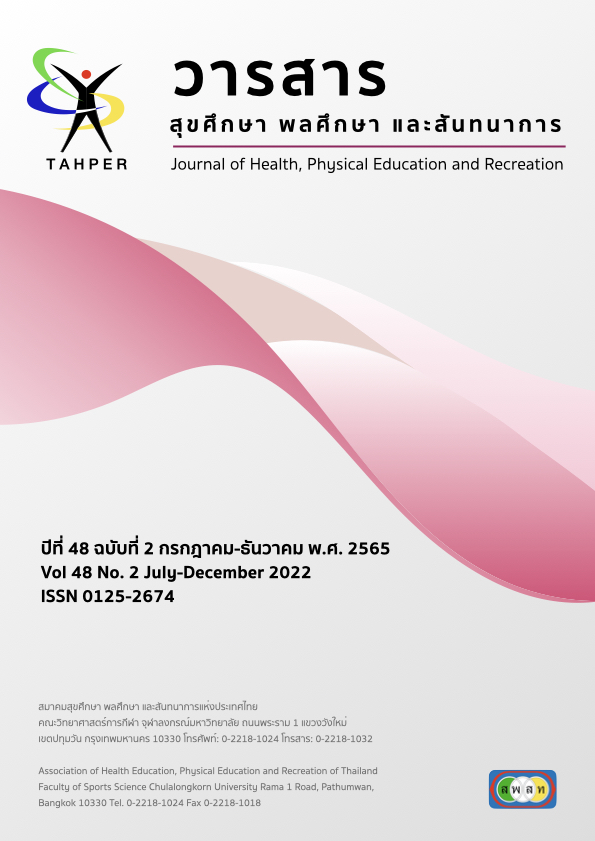ผลของการฝึกแบบสถานีที่มีต่อการพัฒนาการทรงตัวของเด็กออทิสติก Effects of Circuit Training for Balance Development of Autistic Chidren
Main Article Content
Abstract
บทคัดย่อ
การวิจัยในครั้งนี้มีวัตถุประสงค์เพื่อศึกษาผลของการฝึกแบบสถานีที่มีต่อการพัฒนาการ ทรงตัว ของเด็กออทิสติก ประชากรที่ใช้ในการศึกษาวิจัยครั้งนี้ เป็นนักเรียนชาย ในโครงการการศึกษาพิเศษในระดับ 2 ชั้นประถมศึกษาปีที่ 4-6 โรงเรียนแห่งหนึ่งในจังหวัดกรุงเทพมหานคร ประจำภาคปลาย ปีการศึกษา 2561 จำนวน 5 คน ซึ่งได้รับการวินิจฉัยจากแพทย์ว่าเป็นออทิสติกระดับกลุ่มที่มีอาการปานกลาง (Moderate Autism) เครื่องมือที่ใช้ในการวิจัยครั้งนี้คือ 1) โปรแกรมฝึกการทรงตัวแบบสถานี 8 สถานี ประกอบด้วย แทมโพลีน โบซูบอล ขาเดียวรับลูกบอล ขาเดียวรับลูกบอล กระดานทรงตัว ฟิตบอล การก้าวขึ้น-ลง และการเก้าจัตุรัส ที่ผู้วิจัยสร้างขึ้น โดยผ่านการตรวจความเที่ยงตรงเฉพาะหน้า (Face Validity) จากผู้เชี่ยวชาญ จำนวน 5 ท่าน ระยะเวลาในการฝึก 8 สัปดาห์ 2) แบบทดสอบการทรงตัวบนขาข้างเดียวของ Michikawa และคณะ ที่มีความเชื่อถือได้ 0.97 (r =0.97) โดยทำการทดสอบก่อนและหลังการฝึกสัปดาห์ที่ 8 วิเคราะห์ข้อมูลโดยหาค่าเฉลี่ย ส่วนเบี่ยงเบนมาตรฐาน และหาค่าร้อยละของอัตราการเปลี่ยนแปลง
ผลการวิจัยพบว่าค่าเฉลี่ยของการทรงตัวของประชากรก่อนการฝึกเท่ากับ 0.75 วินาทีและค่าเฉลี่ยของการทรงตัวของประชากรหลังการฝึกสัปดาห์ที่ 8 มีค่าเฉลี่ยเท่ากับ 1.67 วินาที ส่วนร้อยละอัตราการเปลี่ยนแปลงของการทรงตัวมีค่าเท่ากับ 58.76 % แสดงให้เห็นว่าการทรงตัวของเด็กออทิสติกที่ดีขึ้นหลังการฝึกโปรแกรมการฝึกการทรงตัวแบบสถานี ในส่วนของพฤติกรรมเริ่มเปลี่ยนในสัปดาห์ท้ายๆ ยอมรับฟังเมื่อผู้วิจัยอธิบายเหตุผล ควบคุมอารมณ์หงุดหงิดของตัวเองได้ดีขึ้น
คำสำคัญ: เด็กออทิสติก, การทรงตัว
Abstract
The purpose of this research was to study the effects of station training on the balanced development of children with autism. The participants of this research were 5 students studying in the special education program at a school in Bangkok. The participants studied in grades 4th to 6th in the first semester of the academic year 2018. They were diagnosed by a doctor as having a moderate level of autism. The instruments of the research were 1) the 8 stations of training on the balance development program created by the researchers consisted of the ball one leg, getting the ball, the board stabilized, fitting the ball, stepping up – down, and the nine squares (these stations were approved by 5 experts for face validity) and 2) the one leg standing test created by Michikawa and colleagues (r=0.97). The participants were tested before and after receiving eight weeks. The collected data were analyzed by mean, standard deviation, and percentage of change rate. The results found that:
The average score on the balance test before receiving the training was 0.75 seconds. After receiving the training for eight weeks, the average score on the balance test was 1.67 seconds. The percentage of the change rate was 58.76. The results indicated that using the station training on balance development improved the balance of children with autism. Behavior began to change in the last weeks. Listen when the researcher explains the reasons for better control of your own irritability.
Keywords : Autistic Chidren, Balance
Article Details

This work is licensed under a Creative Commons Attribution-NonCommercial-NoDerivatives 4.0 International License.
Critical thinking in journals is the right of the author. The Association of Health Education, Physical Education and Recreation of Thailand is not always required, to create diversity in ideas and creativity.
ความคิด ข้อวิพากษ์ในวารสารเป้นสิทธิของผู้เขียน สมาคมสุขศึกษา พลศึกษา และสันทนาการแห่งประเทศไทยไม่จำเป็นต้องเห็นชอบด้วยเสมอไป เพื่อให้เกิดความหลากหลายในความคิดและความสร้างสรรค์


